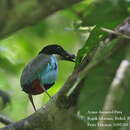Biology
provided by Arkive
This bright bird is generally found on, or near, the ground (4). Here it forages under fallen logs, boulders and in dead leaves for insects and worms. Little is known about breeding in this species; it has been heard calling frequently in April and June, the period of the wet season when most Philippine passerine birds breed, and juveniles have been observed in June and July (2).
Conservation
provided by Arkive
The azure-breasted pitta occurs within the Rajah Sikatuna National Park (3), which protects the vast majority of remaining natural forest on the island of Bohol. Conditions are reported to be fairly good within the park, and the Philippine Department of Natural Resources are reforesting the edges of the park (5). Effective protection of this area is essential for the survival of the azure-breasted pitta, as is the identification and protection of additional important sites (2). It has also been recommended that further research is carried out to establish the current distribution, status and ecological requirements of this stunning bird (2) (3).
Description
provided by Arkive
The strikingly coloured azure-breasted pitta is a ground-dwelling bird from the Philippines. As the name suggests, the breast and sides are a bright azure-blue. The centre of the belly is black, whilst the lower underparts are a contrasting scarlet. The head and tail is black, and the throat is white. The rest of the plumage is largely a metallic greenish-blue. The bill is black, and the legs are light brown to flesh-coloured (2). There are two subspecies; Pitta steeri coelestis differs from Pitta steeri steeri only by having slightly paler, less green plumage (2). Its call is a loud series of four to five explosive, short whistles whep-whep-whep-whep repeated every few seconds (3).
Habitat
provided by Arkive
The azure-breasted pitta occurs in forest with thick undergrowth, often in association with limestone, below elevations of 1,000 meters (4). On Mindanao Island it has also been found in degraded forest (2).
Range
provided by Arkive
Endemic to the Philippines; P. s. steeri occurs on the islands of Samar, Leyte and Bohol, and P. s. coelestis is found exclusively on Mindanao Island (2).
Status
provided by Arkive
Classified as Vulnerable (VU) on the IUCN Red List 2006 (1).
Threats
provided by Arkive
The primary threat to the azure-breasted pitta is the loss of forest habitat on the islands it occupies. All the islands were once completely forested, but now little forest remains. For example, on Mindanao, only 29% of original forest remained in 1988, and that percentage has declined further since. Many of the factors that caused loss of forest habitat in the past still threaten the remaining forest. These include firewood and rattan collection, hunting and trapping, slash-and-burn agriculture, and commercial forestry (5).

